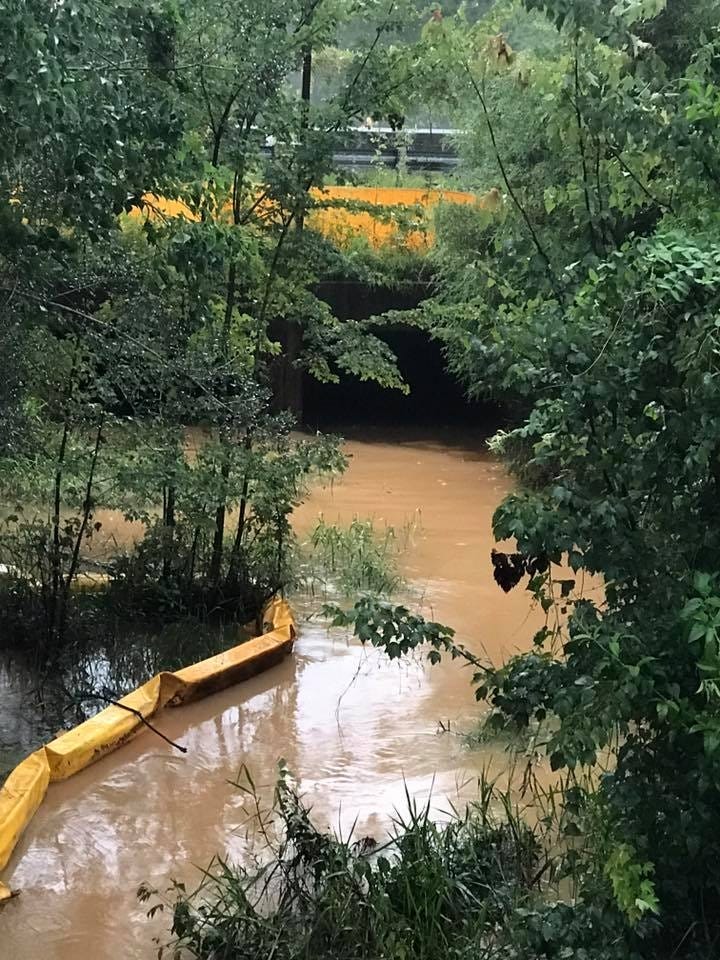![Red clay from Interstate 10 contruction drains into a culvert under the highway, which leads to nearby creeks that run into Indian Bayou, polluting the bayou. [Special to the Press Gazette]](http://127.0.0.1/wordpress/wp-content/uploads/2022/01/ghows-DA-55cf5c20-3c55-0ec8-e053-0100007fc7fd-0a979533.jpeg)
MILTON — Monterey Shores residents are still looking for answers from Santa Rosa County officials to the red clay pollution in Indian Bayou, the body of water on which they live.
Several neighbors gathered at the home of Diane and Gary Nelms to discuss their next steps. The homeowners have joined forces with local marine biologist and the director of the Panhandle Watershed Alliance, Barbara Albrecht.
Albrecht put together a presentation several weeks ago on the causes of Indian Bayou red clay pollution and the possible remedies. She was to present this information to the Board of County Commissioners at a committee meeting but was postponed multiple times.
In a July 21 email to Albrecht, Commissioner Sam Parker asked that she postpone her presentation until the August 7 or 10 meeting.
“County Staff has a meeting with Water Management and it would be a good idea for staff to be familiar with the situation prior to your presentation to the board,” Parker said. “At this time, there are already a few presentations that had been previously scheduled so we want to make you aware that time will be limited to ten minutes. “
Albrecht was able to present her information at the August 7 County Commission Committee meeting. Prior to the meeting, the commissioners informed Albrecht that her presentation needed to be five minutes long as opposed to 10. After the board discussed the first item on the agenda, Albrecht’s presentation was pushed from the fifth item to the ninth. The meeting began at 9 a.m.; the Indian Bayou presentation occurred shortly after 3 p.m.
Albrecht’s presentation, titled “Understanding the System, the Current Condition and the Possible Remedies,” included several aerial views of the area from the past and present, as well as a timeline of construction on Interstate 10 which affected the area.
According to Albrecht’s presentation, ideas for solutions include: paving nearby San Juan Road instead of regularly grading it, which causes red clay to leach into creeks which in turn leak into Indian Bayou; allowing the road to return to its natural state; buy up all the property as a RESTORE project; or identify a mitigation bank to restore the watershed and reconnect the system.
San Juan Road is a red clay street on which there are no properties. Although no one inhabits this road, the county regularly grades the red clay. The cost to pave this road would be $128,000, according to the county public works department.
According to Albrecht, when the most recent construction on Interstate 10 began, which included areas in both Escambia and Santa Rosa counties, Santa Rosa County Water Management allowed Florida Department of Transportation to purchase a $400 permit to drain directly into the waters with no mitigation, or the fixing of damage done by construction; Escambia County assured there was mitigation in the contract.
“If this law is not enforceable, why are they going through the process of getting permits?” Albrecht said, regarding the Clean Water Act, which regulates pollutant discharges into the waters of the United States.
According to Susan Barto, a Monterey Shores neighbor, she has seen much less fish and birds in Indian Bayou in the last year due to the pollution. Jason Martin, another neighbor, agreed and said there have also been fewer crabs in the area; Martin said this pollution affects the homeowners by causing the property values to drop.
“People love the water,” Gary said. “If we don't control the quality of our waters, then our water will become the reason people will leave.”
According to Albrecht and the group of neighbors, they sense a lack of progress dealing with a number of agencies and decision makers about the issue.
According to the group of neighbors, the next step is getting an environmental attorney on their side. Will Dunaway, an Environmental and Land Use Law lawyer out of Pensacola, agreed to visit the case pro bono.
Albrecht said she believes the water management department and FDOT are trying to help with the issue, but it is too late.
“Politics should not drive environmental protection, but it does,” Albrecht said.



This article originally appeared on Santa Rosa Press Gazette: Milton residents take next steps to remedy Indian Bayou pollution
